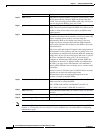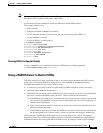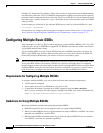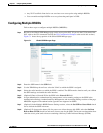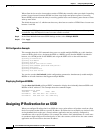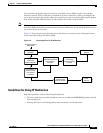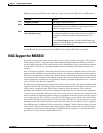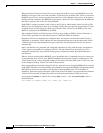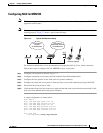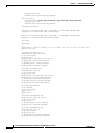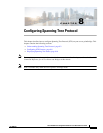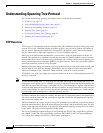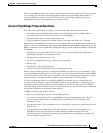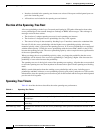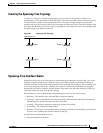
7-12
Cisco IOS Software Configuration Guide for Cisco Aironet Access Points
OL-30644-01
Chapter 7 Configuring Multiple SSIDs
NAC Support for MBSSID
When an infected client associates with an access point and sends its state to the RADIUS server, the
RADIUS server puts it into one of the quarantine VLANs based on its health. This VLAN is sent in the
RADIUS server Access Accept response during the dot1x client authentication process. If the client is
healthy and NAC compliant, the RADIUS server returns a normal VLAN assignment for the SSID and
the client is placed in the correct VLAN and BSSID.
Each SSID is assigned a normal VLAN, which is the VLAN on which healthy clients are placed. The
SSID can also be configured to have up to 3 backup VLANs that correspond to the quarantine VLANs
on which clients are placed based on their state of health. These VLANs for the SSID use the same
BSSID as assigned by the MBSSID for the SSID.
The configured VLANs are different and no VLAN overlap within an SSID is allowed. Therefore, a
VLAN can be specified once and cannot be part of 2 different SSIDs per interface.
Quarantine VLANs are automatically configured under the interface on which the normal VLAN is
configured. A quarantine VLAN inherits the same encryption properties as that of the normal VLAN.
VLANs have the same key/authentication type and the keys for the quarantine VLANs are derived
automatically.
Dot11 sub-interfaces are generated and configured automatically along with the dot1q encapsulation
VLAN (equal to the number of configured VLANs). The sub-interfaces on the wired side is also
configured automatically along with the bridge-group configurations under the Gigabit Ethernet 0
sub-interface.
When a client associates and the RADIUS server determines that it is unhealthy, the server returns one
of the quarantine NAC VLANs in its RADIUS authentication response for dot1x authentication. This
VLAN should be one of the configured backup VLANs under the client SSID. If the VLAN is not one
of the configured backup VLANs, the client is disassociated.
Data corresponding to the all the backup VLANs are sent and received using the BSSID that is assigned
to the SSID. Therefore, all clients (healthy and unhealthy) listening to the BSSID corresponding the the
SSID wake up. Based on the multicast key being used corresponding to the VLAN (healthy or
unhealthy), packet decrypting takes place on the client. Wired side traffic is segregated because different
VLANs are used, thereby ensuring that traffic from infected and uninfected clients do not mix.
A new keyword, backup, is added to the existing vlan <name> | <id> under dot11 ssid <ssid> as
described below:
vlan <name>|<id> [backup <name>|<id>, <name>|<id>, <name>|<id>



